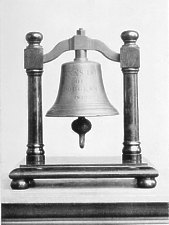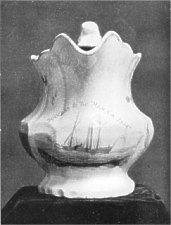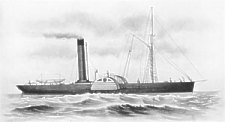
Bell of Steamer "Mona's Isle"

Ware Jug with Inscription
Success foe "Mona's Isle"
[From History of IoMSPCo, 1904]
THE contract for building the Company's first steamer was obtained by John Wood, of Glasgow, and for constructing her engines by Robert Napier, of the same city. this steamer was launched on the 30th of June, 1830, being named, as we have seen, the " Mona's Isle," and she arrived in Douglas on the 14th of August. Her first trip was to the Menai Bridge, with her owners, on the following day. The insular newspapers waxed enthusiastic over her perfections, describing her as being " as beautiful a vessel as ever appeared in this part," and declaring that " her accommodations are, if possible, more than equal to her appearance"(a). A Greenock newspaper is much more moderate in its remarks, merely referring to her "as a superior steam vessel propelled by two engines of superior power." Though small (1), the " Mona's Isle " was fast for her day; she did the passage between Liverpool and Douglas in about eight hours on an average. If Robert Napier, the maker of her engines, stated, in after years, that he was largely indebted for his prosperity and reputation to the name made for him by the " Mona's Isle." Our illustration shows her with her paddle-boxes forward, instead of amidships, with a very thin and lofty funnel, with curious square port-holes, and a square stern. But better than any illustration, we can, or rather could— since she has now for some years disappeared from the Mersey — refer our readers to a vessel almost exactly similar to her, and that is the Cunard Company's steam tender " Satellite " (now broken up), built by Napier from the "Mona's Isle" specifications, which many of them must have seen (2)
The mention of the Cunard Company, by-the-way, reminds us that its claim to be the first Company that had the red funnel with the black top on its steamers, cannot be substantiated. This distinction, we believe, may be justly claimed by the Manx Company
The great popularity of the " Mona's Isle " is shown by the fact that jugs, of what is called " Liverpool transfer" ware, were made, bearing a likeness of her, with the legend, " Success to the 'Mona's Isle."' We give an illustration of one of these jugs, and of her bell, which is now in the Company's office at Douglas.
 Bell of Steamer "Mona's Isle" |
 Ware Jug with Inscription Success foe "Mona's Isle" |

Mona I Built in 1832
(From a drawing of her as a tug
The Company had not long been in possession of the "Mona's Isle", when its directors came to the conclusion that she was too large and valuable to risk on the winter service! To relieve her, therefore, they ordered a smaller boat from the same builder. This vessel, called the "Mona," arrived in the Island in July, 1832, and, prior to taking up the Liverpool Station in October, she was employed in running to Whitehaven and in trips round the Island. She was slightly faster than the "Mona's Isle," or, as the Advertiser grandiloquently puts it, " her motions are, if possible, superior in celerity." She did the passage between Liverpool and Douglas in about seven and a half hours, and, on one occasion, she went from Douglas to Whitehaven in four hours and thirty-five minutes, " a feat which," says the same authority, " distances by far all the accounts we have met with, of extreme celerity of motion over the waves " (a).
The next new steamer, the "Queen of the Isle," was ordered from the same builders and engineers that were responsible for her predecessors. The Glasgow Herald, shortly after the date of her launch (3), stated that she had, " by competent judges, been pronounced one of the finest specimens of naval architecture that has ever floated," and that it was " confidently expected that, when completed, she will be unrivalled in speed and comfort." The prophecy as to the speed of the " Queen of the Isle " came true, it being generally admitted, after she had defeated the "Richmond," a Government packet, which had beaten all the Liverpool steamers, that she was the fastest vessel of her time. It is interesting to note that the Company's first three steamers were called "War Office Steam Packets " (see page 112). Why, we do not know. They certainly had no connection with the War Office.
In 1841, the " Mona" was disposed of to a Liverpool firm, who sold her to the City of Dublin Company. After running for a time in their ordinary service, she was turned into a tug, and traded in Dublin Bay, where she ended her days. The picture we give shows her as she was after she became a tug.
In the same year, the Directors ordered a steamer to be built by John Winram, of Douglas, whose shipbuilding yard is now covered by " Bath Place." Her engines were supplied by Robert Napier. She was named the "King Orry," and proved an excellent sea-boat. With great comparative breadth of beam, she was what would now be called a " tub." The average duration of her passage between Liverpool and Douglas was about seven hours, and her fastest run six hours and twenty minutes. After ten years' service, the "Queen of the Isle " was sold. She was turned into a full-rigged sailing ship, and is said to have been lost off the Falkland Islands. Her engines were transferred to a new steamer, the " Ben-my-Chree," which, being translated, means " Woman (of) my Heart." She was the first steamer to be built of iron.
In 1845, the Company, to cope with the largely increasing traffic, ordered a steamer, the "Tynwald," which was nearly double the size of any of her predecessors, as is very clearly shown by the picture we give of her. Her figure-head, a full-length, represented a Manx Scandinavian King in armour. She had three masts, and a funnel abaft the paddle-boxes. Both she and the " Ben-my-Chree " appear in the very interesting picture of Queen Victoria's visit to Douglas Bay in 1847, reproduced opposite, which also shows the Royal yacht, with her attendants, the " Garland." " Fairy," and " Undine," and Kemp & Co.'s Fleetwood steamer, the " Fenella."
The boilers of the old " Mona's Isle " were now worn out, so that the Directors, who had failed to dispose of her, though she had been advertised for sale since 1837, accepted Napier's offer to supply her with new ones for £500. She was thus enabled to continue in the service till 1851.
The " Mona's Queen," which took her place, was a rather smaller boat than the "Tynwald," but somewhat faster. Her figure-head purported to be a likeness of Queen Victoria. She appears in the foreground of the fine picture painted by Walters, in 1854, next to her is the "Tynwald " (I.), then the ' Ben-my-Chree " (I.), with the " King Orry " (I.) in the harbour.
The passenger traffic at this time continued to increase, and the Directors decided that a larger and faster steamer was required. This resulted in the building of the famous " Douglas," the first steamer which had an upright stem, instead of the picturesque bowsprit and figure-head of her predecessors. In other respects, too, she was a great contrast to them., being long and rather narrow, instead of short and broad. She did seventeen and a quarter knots per hour on her trial trip. Her quickest passage between Liverpool and Douglas was four hours and twenty minutes, and she was said to be the fastest steamer then afloat. We may mention that in her cabin were views of Peel Castle and Cathedral, of Bishop's Court, of the Cathedral at Iona, of Kirk Braddan, of the town and bay of Douglas, of Castletown, Ramsey, Liverpool, etc., and that an enthusiastic account of her appearance in the Manx Sun culminates in the remark, that " altogether the coup d'oeil presented by the cabin is superb." After four years' service she was sold, nominally to Cunard, Wilson & Co., but really to Fraser, Trenholm & Co., the Confederate Agents, for the purpose of running the blockade during the Civil War in America. Painted grey, and re-christened the "Margaret and Jessie," she had a most successful career, till it came to an end in the manner described as follows by the Nassau Guardian (4) (Bahamas):
" We have to record this evening another unjustifiable outrage committed by a Federal gunboat within the prescribed limits of our shores. On Saturday last, the 'Margaret and Jessie,' Captain Wilson, from Charleston for this port, was fallen in with by the Federal steamer 'Rhode island,' off Abaco, and chased till she arrived close to the shore off Jennes Point, Eleuthera. There would be no legal cause of complaint had the pursuit and firing ceased as soon as the 'Margaret and Jessie' approached within the distance of three miles from the land; but as she neared the coast, and was only 20 yards off—that is, between the reef and the land—the gunboat, which was not more than from a quarter to half-a-mile distant, commenced pouring in broadside after broadside, varying the performance with shot, grape and shell—not only to the imminent danger of all on board (and there were ladies among the passengers), but to the serious alarm of the inhabitants of the Island, who suddenly found themselves subjected to a sharp and decisive bombardment. The missiles fired from the 'Rhode Island' ploughed up the earth in various directions, and came in close proximity to, it not actually passing through, dwellings, and drove people to seek refuge between rocks and other projections. This was kept up for miles, and at length the 'Margaret and Jessie' received a shot through her boiler, and another through her bows, which forced her to take the beach, then only fifty yards distant " (5).
Some days later, she got off the beach, and arrived at Nassau. She does not seem to have been again employed as a blockade runner, and we do not know what became of her.
Next came one of the most remarkable and probably one of the most profitable vessels ever owned by the Company, the present "Ellan Vannin," then known as the "Mona's Isle." Though more than seventy feet longer than the " Queen of the Isle," she had a slightly smaller tonnage. Converted into a twin-screw in 1883, and having her name translated, as we have seen, she is still doing good work.
Of the steamers which followed between 1863 and 1876 we need only say that they bore the familiar names of "Snaefell " (6), "Tynwald," "King Orry," and " Ben-my-Chree", that they have greater speed and size than their predecessors; and that they afforded greater and more comfortable accommodation to their passengers. They were all successful boats, especially the first " Snaefell," which accomplished the passage to Liverpool in four hours and twenty-one minutes. She was sold to the "Royal Netherlands Steam Ship Company," to run between Queenborough and Flushing, and so pleased was this Company with her that they also chartered her successor of the same name (7).
In 1878 we have to chronicle an important new departure. Till that year the Company had only paddle steamers, but they then put a single-screw vessel, the "Mona", on the station. She was followed by the twin-screws, " Fenella " and " Peveril". These vessels all proved themselves admirably adapted for the winter service, and they are worked at a much less cost than the paddle steamers. The "Fenella " has a record for usefulness perhaps only second to that of the "Ellan Vannin," but the "Mona" and the "Peveril" have been unfortunate. The former was run into and sunk when lying at anchor off the Mersey, in a fog, and the "Peveril" was sunk off Douglas as the result of a collision. These are the only steamers the Company has ever lost.
The Company then returned to paddles, and made a notable advance by placing the very fine steamer, " Mona's Isle," on the station. She was followed by the equally fine steamer, "Mona's Queen". Not only were these vessels some three-quarters of an hour faster than any of their predecessors—the " Mona's Isle " accomplished the passage between Liverpool and Douglas in three hours and thirty-five minutes—but they were much larger, and had more luxurious accommodation for passengers. In this last respect, indeed, they have not been surpassed by any of their successors. In 1888, the steamers "Queen Victoria " and "Prince of Wales" were added to the fleet(8). Then came the " Tynwald," and the " Empress Queen." The " Tynwald " is a twinscrew steamer, certified to carry nearly twice as many passengers as the " Fenella," and with a speed about equal to that of the " Mona's Isle." The "Empress Queen " is said to be the largest and swiftest paddle steamer in existence. As will be seen by the copy of her "log" (9) given below, she has only surpassed the "Prince of Wales's" record of two hours and fifty-nine minutes between the "Rock" and Douglas by two minutes, but she is, on an average, some twelve minutes faster between Liverpool and Douglas than that steamer. She has accommodation for no less than 2,000 passengers. A glance at Appendix A will show that she is more than three times as long as the first steamer—the " Mona's Isle" (10) owned by the Company, and that the proportion of her tonnage and indicated horse-power is as eleven to one and thirteen to one, respectively.
The Company's present fleet of thirteen vessels is completed by the purchase of the " Dora," a singlescrew steamer, from the London and South Western Railway Company, and of the "Calais-Douvres " (11). These two vessels, under their names of " Douglas " and "Mona," have proved themselves useful acquisitions.
(a) Manks Advertiser.
(1) The dimensions, etc., of the steamers will be found in Appendix A
(2) The Cunard Company has kindly sent the dimensions of the "Satellite" (per Mr. Thos. Orford). They are—Length, 108ft. bin.; breadth, 18 ft. 9 in.; depth, 9 ft. 8 in. She was thus 7 ft. 6 in. shorter than the "Mona's Isle."
(3) The 3rd of May, 1834.
(4) Of June the 3rd, 1863.
(5) Manx Sun, July the 4th, 1863.
(6) There were two steamers of this name.
(7) The present "Snaefell"
(8) See page 75.
(9)
|
P. S. " EMPRESS QUEEN. |
|
|
hrs mins |
hrs mins |
|
Liverpool Landing Stage dep. 2 3 |
From Stage to Douglas Head 3 9 |
|
,, Tower ,, 2 6 |
,, Tower ,, 3 2 |
|
,, Rock ,, 2 11 |
,, Rock ,, 2 57 |
|
,, Bar , ,, 2 41 |
,, Bar ,, 2 27 |
|
Douglas Head arr. 5 8 |
|
|
Mean Speed, Bar to Douglas Head, 22.85 knots, |
|
|
COPY OF LOG FOR JULY THE 20TH, 1898. |
|
|
hrs mins |
hrs mins |
|
Liverpool Landing Stage dep. 2 6 |
From Stage to Douglas Head 3 6 |
|
,, Tower ,, 2 9 |
,, Tower ,, 3 3 |
|
,, Rock ,, 2 15 |
,, Rock ,, 2 57 |
|
,, Bar , ,, 2 46 |
,, Bar ,, 2 26 |
|
Douglas Head arr. 5 12 |
|
|
Mean Speed, Bar to Douglas Head, 23.01 knots, |
|
(10) As showing the advance in size of the passenger steamers in the Isle of Man service, it may be mentioned that the "Empress Queen" is the same length as the " Scotia," built in 1862 for the Cunard Company The "Scotia" was the last paddle-steamer built to cross the Atlantic.
(11) see page 78
|
|
||
|
Any comments, errors or omissions
gratefully received The
Editor |
||